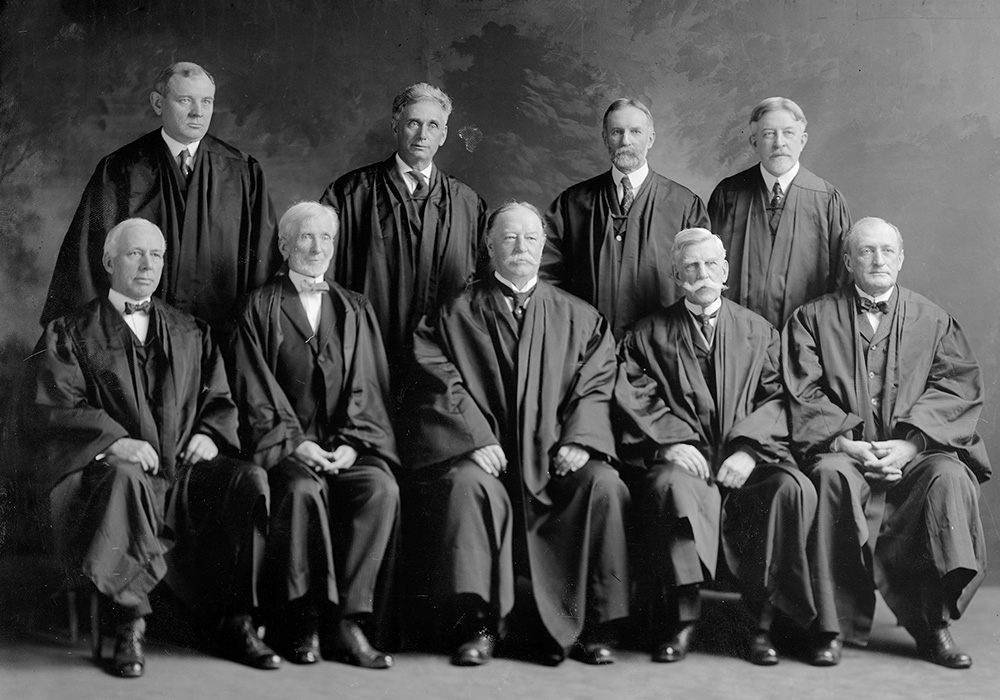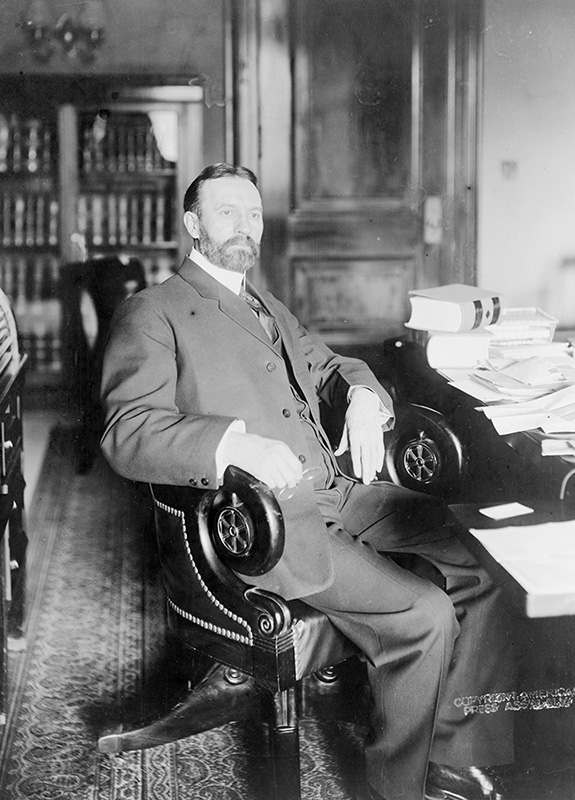
When Chief Justice White died in 1921, President Harding made William H. Taft Chief Justice, the only former Chief Executive ever to hold the highest judicial office. Taft was vastly delighted, for the Chief Justiceship, not the Presidency, had always been the honor he wanted most.
In 1922, the Court reviewed the Child Labor Law. The Court decided that this law imposed a penalty, not a tax, and held it invalid. Chief Justice Taft wrote an opinion saying the Tenth Amendment reserves problems like child labor for the states to solve.
Not until 1941 did the Court overrule its child labor decisions. Meanwhile, reformers urged an amendment to protect children, and called the Court a “Supreme Legislature.” They pointed out: “The vote of one member of the Supreme Court may exceed the collective power of 435 Representatives and 96 Senators, or even of 100,000,000 people.”
“Any agitator who read these thirty-four pages to a mob would not stir them to violence, except possibly against himself,” decided one reader of Benjamin Gitlow’s “Left Wing Manifesto.” But when that pamphlet appeared in 1919, New York authorities arrested Gitlow under the state’s criminal anarchy law.
Gitlow applied to the Supreme Court. Seven Justices upheld his conviction and the New York statute. But they assumed–for the first time–that freedom of speech and of the press, which the First Amendment protects from any Act of Congress, are among the rights which the Fourteenth Amendment forbids any state to abridge.
Oliver Wendell Holmes and Louis D. Brandeis would have set Gitlow free. As Holmes explained, they did not think his “redundant discourse” a public danger. The majority called it “a direct incitement.” Holmes replied calmly: “Every idea is an incitement.”
Gitlow served three years in Sing Sing prison. Later he became one of the Communist Party’s bitterest critics.
Frank Moore faced an Arkansas electric chair; so did Ed Hicks, J. E. Knox, Ed Coleman, and Paul Hall. All five were Negroes. When a federal district court said that it could not help; them, they took their petition for a writ of habeas corpus to the Supreme Court, and raised the question: How does the Constitution protect the right to a fair trial in state courts?
Announcing the ruling of the Court, Justice Holmes gave their story as it appeared from the trial record and the sworn statements of other witnesses:
Black sharecroppers in the cotton country around Elaine, Arkansas, decided that their landlords oppressed and cheated them. On the night of September 30, 1919, they met in the Hoop Spur church to plan ways of getting help from a lawyer. Armed white men attacked them; in the fight that followed, one white man was killed.
News and rumors spread; armed posses hurried to Elaine. Blacks were hunted down and shot, even women working in the cotton fields. On October 1, Clinton Lee, a white man, was killed; Moore, Hicks, Knox, Coleman, and Hall were arrested for murder.
The Governor asked the Army to restore order, and named a Committee of Seven to investigate the riots. When a lynch mob surrounded the jail, soldiers stood guard while the committee promised that the law would execute the five murderers. The mob waited to see what would happen.
Two white men and several blacks swore later that the committee tortured blacks until they agreed to testify against the prisoners. Indicted by a white grand jury for first-degree murder, the defendants faced a white trial jury on November 3; a threatening crowd filled the courthouse and the streets outside. In 45 minutes the trial was over; in two or three minutes the jury gave its verdict: “Guilty.”
From the affidavits presented to the Court, Holmes concluded, “if any prisoner by any chance had been acquitted by a jury he could not have escaped the mob.”
All appeals in the state courts had failed. Normally, federal courts will not interfere with the courts of any state on matters of state law. But, warned Holmes, if “the whole proceeding is a mask”—if “an irresistible wave of public passion” sweeps the prisoners through the courts “to the fatal end”—then nothing can prevent the Supreme Court “from securing to the petitioners their constitutional rights.”
The district judge should have examined the facts for himself, Holmes ruled, to see if the story in Moore’s petition was true and if the state had not given its prisoners a fair trial. Moore v. Dempsey went back for the district judge to hear.
Eventually, all five defendants went free; so did nearly a hundred other blacks arrested during the riots. Federal judges had a new precedent, citizens a new safeguard. Justice may wear a blindfold, ruled the Supreme Court, but not a mask.
Considering the clogged machinery of the federal courts, where the caseload was rising again, Chief Justice Taft remarked: “A rich man can stand the delay . . . but the poor man always suffers.” Taft set out to improve the whole federal judiciary.
He planned the Conference of Senior Circuit Court Judges, a source of many reforms in judicial practice. The law establishing the conference permitted judges of one area to help elsewhere on courts swamped with work. Then Taft broke tradition to lobby for the “Judges’ Bill,” passed in 1925.
By limiting the right of appeal, this law let the Supreme Court devote its attention to constitutional issues and important questions of federal law. In most cases since 1925, the parties ask permission to be heard; the Justices grant or deny it at discretion.

Before gaining freedom to choose cases, the Court surprised many observers in 1923 by a choice of precedents to decide Adkins v. Children’s Hospital. In the majority opinion, Justice George Sutherland returned to the “meddlesome interferences” doctrine of Lochner v. New York, the bakery case of 1905.
Congress had passed a law to guarantee minimum wages for women and children working in the District of Columbia. A children’s hospital attacked the law; the case reached the Supreme Court. Five Justices agreed that the law violated the due process clause of the Fifth Amendment and the right to liberty of contract. Sutherland hinted that since women had won the right to vote they were legally equal to men, so Congress should not single them out for special protection.
“It will need more than the Nineteenth Amendment to convince me that there are no differences between men and women,” Holmes retorted, dissenting, “or that legislation cannot take those differences into account.” On the “dogma” of liberty of contract, he remarked: “pretty much all law consists in forbidding men to do some things that they want to do, and contract is no more exempt from law than other acts.”
Taft also dissented. He had always supposed, he said, that Lochner had been overruled by later decisions; and, he added, poor workers cannot meet an employer on an equal level of choice. But Arizona, Arkansas, and New York saw their minimum-wage laws go down under the Adkins precedent.
Justice Sutherland always believed that judges were the best guardians of liberty. Chosen for learning, ability, and impartiality, judges were safer guides than any other men, Courts were wiser than crowds.
“I am an optimist in all things,” Sutherland said once. He felt sure that evolution’s universal laws were making the world better and that meddlesome legislation could only bring trouble. Often he spoke for the famous “four horsemen”—himself, Pierce Butler, James C. McReynolds, and Willis Van Devanter. Joined by one other Justice, they could say what laws were valid.
By 1930 Harvard Professor Felix Frankfurter took stock: “Since 1920 the Court has invalidated more legislation than in fifty years preceding.” When Taft retired that year, President Hoover wanted Charles Evans Hughes for Chief Justice. Debating the appointment, one Senator accused the Justices of “fixing policies for the people . . . when they should leave that to Congress,” another called the Court “the economic dictator in the United States.” But the Senate confirmed Hughes for Chief, and Owen J. Roberts for Associate a few months later.




